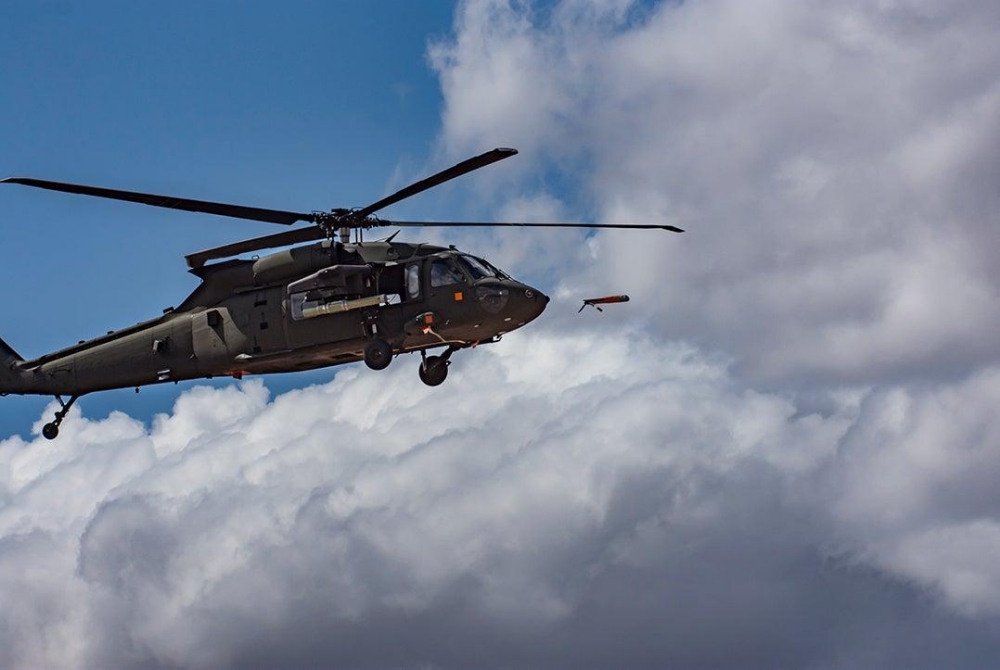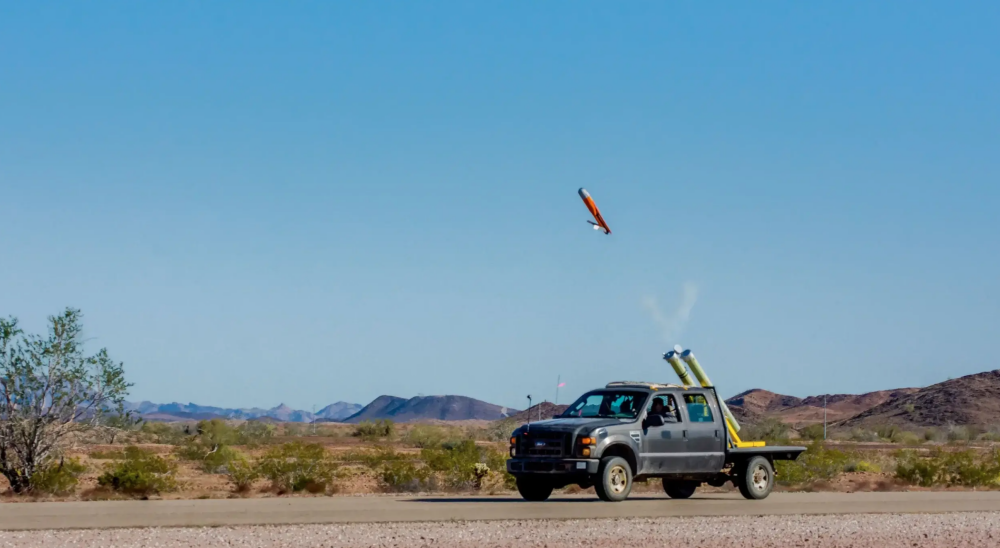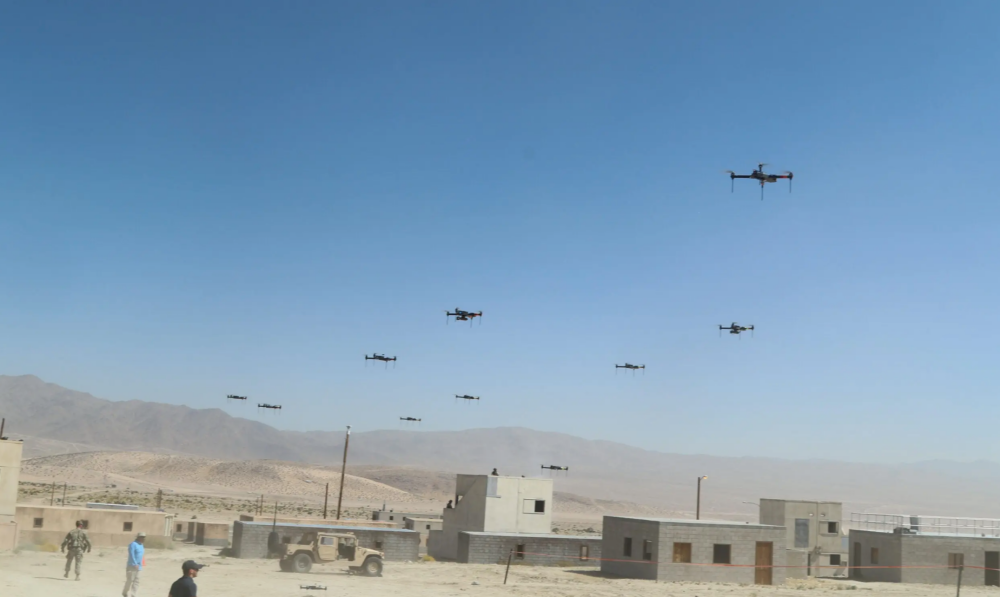The U.S. Army plans to launch a swarm of up to 30 small drones networked into a swarm later this month over the Utah desert as part of an international exercise. Deployed from an advanced echelon of a dual air-assault mission by helicopter-borne troops from the U.S. Army and allied participants, the swarm will be the largest group of interactive air-launched effects (ALEs) the Army has ever tested.
A mix of Area-I’s small Air-Launched, Tube-Integrated, Unmanned System 600 (ALTIUS 600) and Raytheon-built Coyote drones will be launched from a variety of aircraft and ground vehicles at the Army’s 2022 Experimental Demonstration Gateway Exercise (EDGE 22) that runs from April 25 to May 12 at Dugway Proving Ground near Salt Lake City, Utah.
“I think what you’re going to see is an expansive use of electronic warfare and an expansive use of our interactive drone swarm,” Maj. Gen. Walter Rugen, head of the Army’s Future Vertical Lift Cross-Functional Team, told The War Zone in a recent interview. “We feel like we’re going to be flying the largest interactive drone swarm ever in partnership with DARPA and our science and technology experts out of Aviation and Missile Command.”

An ALTIUS-600 is launched from a UH-60 Black Hawk at Yuma Proving Ground, Arizona. Courtesy photo provided by Yuma Proving Ground
ALE is shorthand for a variety of unmanned systems launched from aircraft that can then be controlled by the aircraft crew or fly autonomously and feed information back to both the helicopter and networked ground troops.
The ALTIUS-600 model weighs between 20-and 27 pounds, depending on payload, has a range of 276 miles, and endurance of at least four hours. As well as the PILS, the drone can be launched from the Common Launch Tube (CLT) and the Reconfigurable Integrated-weapons Platform (RIwP). It can carry a variety of payloads to perform a range of intelligence, surveillance, and reconnaissance (ISR) and signals intelligence (SIGINT) missions. ALTIUS also can be fitted with a warhead for offensive missions or employed as a counter-drone weapon using Lockheed Martin’s MoRFIUS, or Mobile Radio Frequency-Integrated UAS Suppressor. Area-I last year announced the ALTIUS-700, which has three times the carrying capacity of the -600 with five hours of flight endurance and customizable payloads that include surveillance, counter-UAS, electronic warfare, munitions and signals intelligence.
Block 1 Coyote drones, made by Raytheon, made their first flights in 2007, featuring a rear pusher prop, a set of pop-out wings and a pop-up twin-tail. These initial Coyotes were marketed as low-cost intelligence, surveillance, and reconnaissance platforms, but ended up being somewhat of a testbed for a wide variety of applications including being air-launched by NOAA aircraft to gather data from inside hurricanes in 2017.
Block 2 didn’t appear publicly until 2018 sporting a more missile-like appearance without wings and was specifically designed as a counter-drone system. A Block 3 version debuted last year developed for Navy unmanned vessels to launch from above and below the surface of the water.
ALEs carrying various sensing capabilities will be launched from aircraft, ground vehicles and by ground troops, then networked together as they fly toward an intended assault landing zone. The swarm will converge on the target area, sense enemy forces using infrared sensors and electronic warfare payloads that can detect signals emissions, fix their positions and feed that information back through the network to command posts and manned assault aircraft, Rugen said.
“We’ll be launching them pretty much, you know, Monster Garage-style, anyway we can,” Rugen said. “Which again shows, in my mind, just the flexibility of our air-launched effects initiatives, because we can launch it from the air. We can launch it from the ground. We can launch from fixed-wing, rotary-wing, any type of ground vehicle.”

An ALTIUS is launched from an Area-I Pneumatically Integrated Launch System (PILS) during EDGE 21. Area-I photo
EDGE 22 is part of a series of rolling experimentation exercises hosted by the Army to evaluate new technologies and operational concepts. Rugen expects about 20 other Defense Department organizations to participate in 2022, including other program executive offices and CFTs, the Army’s ISR Task Force, and the Artificial Intelligence Integration Center and the Defense Advanced Research Projects Agency (DARPA). At least 50 technology objectives will be tested at the event, including how the U.S. sensor-to-shooter network can operate and intertwine with allied capabilities, which adds another layer of complexity. To identify potential network bottlenecks and speed up the decision-making process, Australia, Canada, France, Germany, Italy, the Netherlands and the U.K. will attempt an air assault alongside the U.S. during the exercise.
EDGE pulls lessons from last fall’s Project Convergence 2021 (PC 21) exercise and paves the way for the upcoming PC 22 later this year.
During PC 21, two ALTIUS 600 drones were launched from and controlled by a UH-60 Black Hawk outfitted with DARPA’s autonomous brain called the Aircrew Labor In-Cockpit Automation System, becoming a second and third set of airborne sensors feeding reconnaissance and targeting data back over the secure network. Successful testing on smaller drone swarms has led to the planned multi-vehicle launch of up to 30 drones in support of a pair of air assaults on a defended landing zone behind enemy lines, Rugen said. The swarm will be used to sense, detect, identify and potentially strike enemy positions before manned helicopters arrive on scene.
“Our concept is generating decision dominance, converging our effects at the time and place of our choosing, then generating that overmatch in a very fast and agile way,” Rugen said. “Extending the network out there is going to be important to us.”
The idea is to quickly deploy swarms of spy drones and/or loitering munitions deep behind enemy lines to find and identify enemy forces. Networked together, the swarm can scan wide areas of terrain autonomously and feed video and targeting information to manned platforms holding beyond an enemy’s strike range. The DARPA last year tested a similar concept, though based on small-unit deploying swarms of drones for various missions related to urban combat rather than an air assault. The Army envisions larger unmanned platforms like the MQ-1C Gray Eagle as part of that stand-off equation, as well.
The plan is for each ALE to perform at least one of a set of defined reconnaissance and targeting mission sets listed as”detect, identify, locate, report,” or DILR. Drones in the swarm will carry either passive or active capabilities. Payloads on passive drones include electro-optical or infrared imaging cameras or sensors capable of locating enemy electromagnetic emissions, including from communications systems and radars. Active elements of the swarm could carry electronic jamming equipment to interrupt an opponent’s sensing or communication capabilities, or a warhead to directly strike enemy positions.
This is the same general scenario seen in a video released in April by the Army’s Combat Capabilities Development Command Aviation & Missile Center, seen below:
Once targets have been fixed and identified, some aircraft in the swarm can be employed as suicide drones to strike targets while others act as spotters for indirect fire or precision munitions launched from aircraft. Dividing missions and payloads among the drones in a swarm gives the networked group of drones more flexibility because each aircraft is not required to perform every mission. It also allows individual UAS to be smaller and cheaper because they do not have to carry both recon and strike equipment.
“In this case, that interactive swarm will generate overmatch where the penetration is needed,” Rugen said. “Once we conduct that penetration, we’ll be able to generate and set the conditions for two air assaults, vertical envelopments, one U.S. and one international.”
The Army is weighing what swarms can do on future battlefields when launched in numerous configurations and sizes from all number of platforms, including ground vehicles, high-altitude balloons, long-range missiles and other unmanned systems.
ALTIUS has already been launched from Army MQ-1C unmanned aircraft and UH-60 Black Hawk helicopters, as well as from an Air Force XQ-58A Valkyrie stealthy unmanned aircraft. Using an Area-I Pneumatically Integrated Launch Systems (PILS) it has been launched in the past from C-130, AC-130J, P-3, and civilian aircraft, as well as from a DAGOR ultra-light tactical vehicle.
All of this is in service of providing the Army with a wider, more detailed view of future battlefields before manned aircraft and ground troops maneuver against enemy forces. ALTIUS has served as a test platform for what eventually will be a family of ALEs with a range of payload and swarming capabilities, which you can read more about in this detailed War Zone piece.

The Army has tested larger swarms of smaller drones, like this flock of 40 quadcopters at the National Training Center in California, but EDGE 22 will see the largest swarm of air-launched effects to date. U.S. Army Photo by Pv2 James Newsome
Essential to deploying drone swarms, and the larger Army concept of combined arms maneuver is a jam-resistant network sturdy and stealthy enough to operate in a denied or degraded communications environment, Rugen said. Drones themselves can be used as network repeaters to provide beyond-line-of-sight communication between forward-deployed forces and rear command posts.
A tiered, secure network of surveillance and long-range strike capabilities will allow the Army to “shape” conditions before assaulting defended positions and ensuring its forces are striking military targets in highly complex environments like the urban combat being conducted by Russian forces in Ukraine, Rugen said.
“What’s really on my mind, and you can see it play out in Ukraine, is our enemies fire on detect. We fire on identify,” he said. “We’re already in kind of a latent position, because of our culture and our values and we’re gonna hold to that. So we’ve got to speed it up and that’s really what I’m very, very interested in. I want to be faster than them even though they’re kind of cheating.”
However the EDGE 22 experiment with drone swarming turns out, the Army will continue to push toward a highly mobile, networked battlefield. PC22 in the fall could see an even larger swarm performing more complex missions in service of that goal.
Source: The Drive


